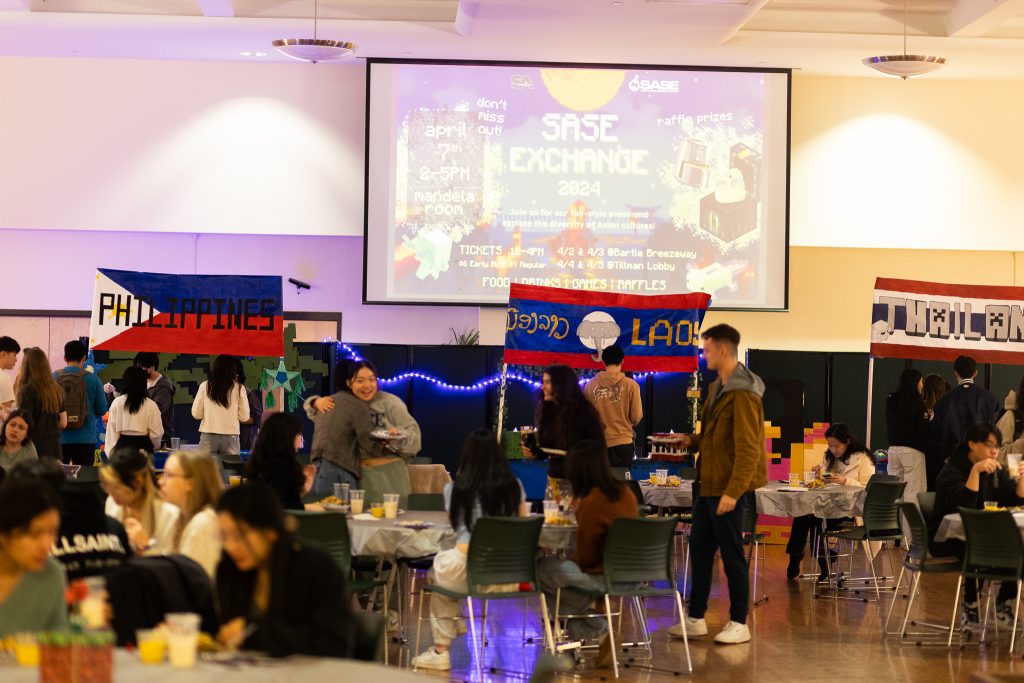The Society of Asian Scientists and Engineers hosted their third-annual SASE Exchange fair last Sunday, featuring activities, traditional food and games from seven different countries.
Visitors were able to participate in interactive activities at seven stations throughout the Mandela Room, which were representative of China, India, Japan, Philippines, South Korea, Thailand and Laos. Each table also featured homemade food from its respective country, which students could enjoy at the banquet tables.
A Minecraft theme tied the event together with the idea of each station as cultural building blocks. The decor, designed by SASE E-Board members, included pixelated posters at each table, original banners and a Minecraft boat with water lilies at the center of the Mandela Room.
SASE is a professional organization that has been bringing Asian students in STEM together since 201. The organization emphasizes the core tenets of professionalism, diversity and service, with previous events including SASE Science Week, resume and cover letter workshops, and mentorship opportunities.
Christian Tai, freshman ambassador for SASE and majoring in mechanical engineering, discussed the significance of SASE Exchange for the organization as a whole and the Binghamton University community.
“SASE exchange is our one big event of the year, and I feel like it’s very important as a professional organization to connect back to the community,” Tai said. “Because even though we are a professional organization, we are a cultural organization. I think connecting back to all cultures, as the A in SASE stands for Asian, is very important to embody all the different cultures. It’s great to see everyone come here and not have to focus on the engineering and science part of our name, and focus on the culture.”
The fair featured a diversity of cuisines from the seven countries. The cuisines included prawn crackers from China, mango lassi from India and karaage — crispy fried chicken, which is eaten as an appetizer or entree — from Japan. The Philippines station offered samalamig, a sweet street-food beverage typically consumed chilled, while the South Korean station served up japchae, a stir-fry noodle dish. Thailand featured khao pat, or Thai fried rice, and the Laos station had prepared a minced meat salad known as beef larb.
The food was prepared and cooked by the SASE E-Board, who brought their various cultural knowledge together for the event according to Rose Deutsch, professional chair and event coordinator for SASE and a junior majoring in integrative neuroscience. Working together with Sodexo to rent out kitchen space enabled SASE to provide their own food for the fair. Deutsch explained that this year marks the first time that SASE has prepared their own food for an event, in an effort to make the event even bigger than last year’s.
The food preparation process presented a unique challenge for SASE, according to Ashley Cheung, event coordinator and senior advisor for SASE who is majoring in industrial and systems engineering. After deciding upon the cultural dishes and their corresponding recipes, SASE ordered the ingredients through Sodexo, which resulted in a surplus of food. Despite these unforeseen challenges, the E-Board worked together to put on a cohesive event.
“It was long and demanding, yet rewarding to coordinate all aspects of this event,” Cheung wrote in an email. “There [were] so many tasks that have to be completed, as well as meetings that [needed] to be held with various parties, and cooking the food ourselves added a new layer of complexity. I worked with two other event coordinators, and together we did all of the planning for this event, however, we wouldn’t have been able to do it without the support of the rest of our [E-Board].”
In addition to preparing their own food, the event involved a large commitment from the E-Board for the decor. The E-Board spent Saturdays from around 10 a.m. to 1 p.m. creating the decor ahead of SASE Exchange, according to Deutsch.
Activities at SASE Exchange included plant potting, a crafting table where students could fold origami and weave a mini basket, a shooting range and a table where visitors could make Chinese knots out of coins and red thread. The event also featured a scavenger hunt with a raffle prize for interested attendees.
Deutsch described how the cultural element of SASE Exchange is meaningful to her, as someone who is adopted and of Asian background.
“I love that SASE not only represents East Asian cultures, but also Southeast Asian, central Asian,” Deutsch said. “We try to choose things from a good variety of our [general body] … We’re always looking to expand more. We also try to choose stations that represent our E-Board.”
SASE Exchange brought together members of the Asian community and the broader community at BU, with SASE extending special thanks to the organizations in attendance.
Tai emphasized that element of community when asked about his membership in SASE.
“I’m glad that I joined because SASE has become such a family to me,” Tai said. “All the decorations that we created here, [the] long hours, [was] so much work. But you know what they say when you do what you love — you never work a day in your life. That’s what it feels like. Everyone here is such a great family, and every time we work together, it feels like we’re hanging out.”



